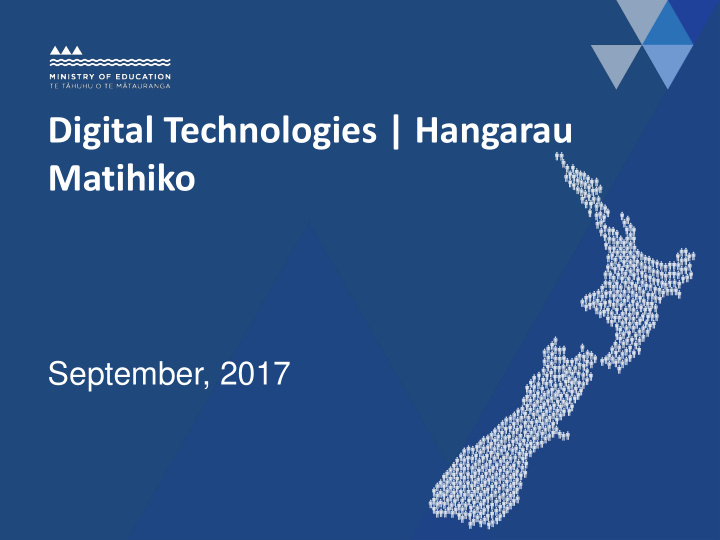



Digital Technologies | Hangarau Matihiko September, 2017
Why DT | HM? • New Zealand is a digital nation. Digital technologies are transforming how we live, shaping our homes and workplaces • Our world is evolving rapidly, and education is at the centre of it all DRAFT 2 education.govt.nz
How we got here: • On 5 July 2016 Education Minister Hekia Parata announced the strengthening of Digital Technologies | Hangarau Matihiko. • Becoming a strand of the Technology learning area in The New Zealand Curriculum and within the Hangarau Wāhanga Ako of Te Marautanga o Aotearoa. • Working with 40 plus stakeholder organisations • From 2018, it will be included in the New Zealand Curriculum and Te Marautanga o Aotearoa . • Mandated for both the New Zealand Curriculum and Te Marautanga o Aotearoa as of 2020. 3 education.govt.nz
Purpose of today’s session • To understand the ‘shape’ of the curriculum change • To discuss how early learning can be involved DRAFT 4 education.govt.nz
Responding to challenges for education in a digital world • Our economy and society has a need for people with the right skills to drive digital innovation and growth • Learners need to be able to understand and create digital technologies to succeed in further education, and the world of work. • The changes will involve extensive support to parents, whānau, teachers, school, kura, and the early learning services they work with Use Create Develop DRAFT 5 education.govt.nz
What’s New? DT | HM has been strengthened within the Technology learning area and Hangarau Wāhanga Ako education.govt.nz
What’s New? DT | HM has been strengthened within the Technology learning area and Hangarau Wāhanga Ako education.govt.nz
Two New Technological Areas For both English and Māori medium: • Computational Thinking in Digital Technologies (Te Whakaaro Rorohiko) • Understanding the computer science principles that underlie all digital technologies • Develop computational and algorithmic thinking skills • Know how to develop instructions to control digital technologies and solve problems • Designing and Delivering Digital Outcomes (Te Hoahoa me te Hanga Otinga Matihiko) • Know how to use digital technologies to get the job done • Understand the digital world, how to use technologies ethically, and the implications of being a digital citizen, • Understand how to design and operate digital devices and systems 8 education.govt.nz
Te Ao Māori unique content Two Māori medium unique progressions / He Whakatupuranga Kaupapa Māori Ake •Ngā Āria o Ngā Whanaketanga Hangarau Matihiko Arareo ( Concepts of Digital Technology) • focus on the development of different concepts of digital technologies through Māori values, knowledge, language and education. • enables students to learn about and use digital technologies in various situations from a Māori worldview. • Te Tangata me te Rorohiko (People and Computers) •focus on the demonstration of incorporating Māori values and principles that ensure designers and users are considerate of how their designs will have a positive impact on them, their whānau, hapū, iwi and the local and global environment. education.govt.nz
Proposed changes • Revised Learning Area statement • Explicit DT content – developed as two learning progressions in two Technological Areas • Progress Outcomes describe the significant DT learning steps • Outcome Statements – describing “digitally capable” Year 10 and Year 13 students • Exemplars Existing Achievement Objectives have been retained without change 10 education.govt.nz
The changes explained... • Progress Outcomes : Clearly describes the significant steps learners take as they progress in Digital Technologies from school entry to the end of year 13 • Outcome statements: the desirable outcomes, describe what learners, whānau and key stakeholders can expect at key points in the education pathway education.govt.nz
Across the Learning Pathway Early Childhood Education The strengthened DT | HM content links closely to Te Whāriki . Te Whāriki : • Promotes the integrated use of digital technologies • Promotes using digital technologies to access and engage with the wider world • Become increasingly capable of using a range of strategies for reasoning / problem solving 12 education.govt.nz
Across the Learning Pathway Early Childhood Education 13 education.govt.nz
Across the Learning Pathway Early Childhood Education We are currently designing a variety of interventions in the Digital Fluency programme using a pathways approach (refer handout). We expect that Early Learning Services who are involved in a Community of Learning would be part of any application for Professional Learning and Development focused on Digital Fluency. We also expect the national programme to introduce new curriculum to teachers as well as early childhood teachers who are looking at the links between Te Whāriki , NZC and TMoA. 14 education.govt.nz
Across the Learning Pathway Early Childhood Education We welcome involvement of the Early Learning sector in continued development of the package of initiatives. The best vehicle for this is the Implementation Reference Group. It will meet again in October / November to consider feedback from the consultation Lyn Granshaw is the nominated member of the Ministry’s Early Childhood Advisory on the Reference Group. 15 education.govt.nz
How you can help Your feedback is valuable to us. We believe this new digital technologies curriculum will help equip our children and young people for the digital world of today and the future. Please send any further questions to: digi.tech@education.govt.nz DRAFT 16 education.govt.nz
Recommend
More recommend